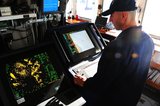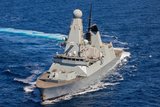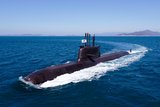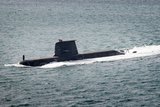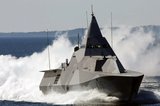US Navy continues ASW mission package testing
The US Navy’s Program Executive Office Unmanned and Small Combatants (PEO USC) has reached a new milestone on its Littoral Combat Ship (LCS) anti-submarine warfare (ASW) mission package testing, NAVSEA announced on 16 July.
During the testing period - Dockside-1 testing - the Dual-mode ARray Transmitter (DART) mission system towed body and associated launch-and-recovery assembly components were tested in Fort Pierce, Florida.
An in-water test of the active array was also carried out at the Naval Undersea Warfare Center Seneca Lake Detachment’s test facility in Dresden, New York. This was the first opportunity for the new technology to be demonstrated in an open-water test environment, which will give better understanding of how the system will perform when deployed on LCS. The successful completion of the test event provided valuable information to the navy on performance specifications and options for future modifications.
Dockside-2 testing, which is planned for autumn 2018, will expand the scope of DART system integration to add three additional Raytheon mission modules to complete the system. The navy will take delivery of the DART mission system from Raytheon later in 2018 and plans to take the system to the Atlantic Undersea Test and Evaluation Center early in 2019 for additional testing.
The LCS fitted with these mission systems is designed to provide US forces with assured access to coastal areas.
More from Naval Warfare
-
![Is South Korea finally being taken seriously for Western submarine programmes?]()
Is South Korea finally being taken seriously for Western submarine programmes?
South Korean shipbuilders are beginning to make their mark beyond Asia, competing for major North American and European submarine programmes and becoming serious contenders on a global scale.
-
![AUKUS Pillar 2 could narrow focus to “four key areas” says UK official]()
AUKUS Pillar 2 could narrow focus to “four key areas” says UK official
Few concrete ideas have emerged so far on which “advanced capabilities” will be brought forward under Pillar 2 of the AUKUS partnership, but the Pentagon’s review of the programme could bring more clarity.
-
![Sweden’s decision on four new warships inches closer as it eyes UK, France and Spain]()
Sweden’s decision on four new warships inches closer as it eyes UK, France and Spain
Sweden decided last year that it wanted a significantly larger warship for its Luleå Class programme than originally planned, with three likely contenders that could potentially deliver within the country’s tight schedule.
-
![How the use of artificial intelligence will affect the US Coast Guard’s acquisitions]()
How the use of artificial intelligence will affect the US Coast Guard’s acquisitions
The USCG is pursuing AI tools to improve the way the service conducts its procurement and fielding processes.









